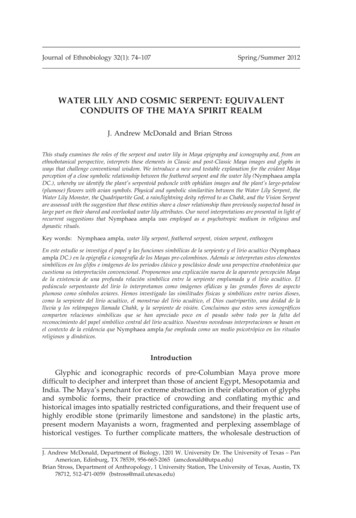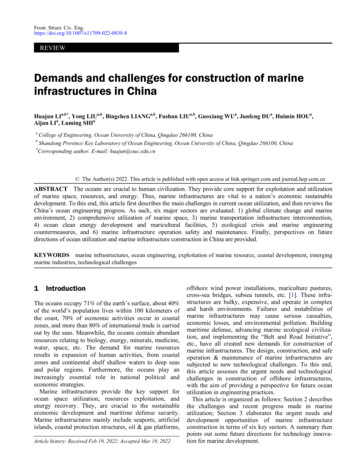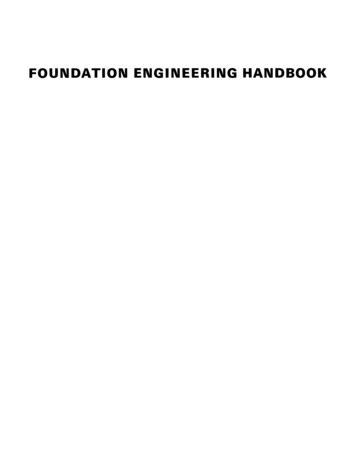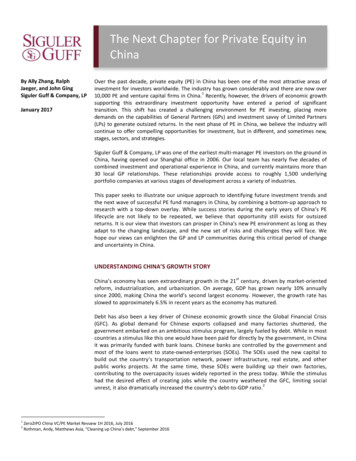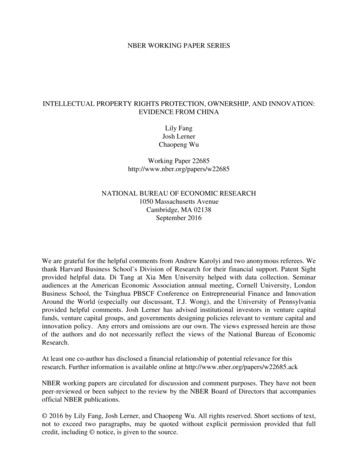
Transcription
NBER WORKING PAPER SERIESINTELLECTUAL PROPERTY RIGHTS PROTECTION, OWNERSHIP, AND INNOVATION:EVIDENCE FROM CHINALily FangJosh LernerChaopeng WuWorking Paper 22685http://www.nber.org/papers/w22685NATIONAL BUREAU OF ECONOMIC RESEARCH1050 Massachusetts AvenueCambridge, MA 02138September 2016We are grateful for the helpful comments from Andrew Karolyi and two anonymous referees. Wethank Harvard Business School’s Division of Research for their financial support. Patent Sightprovided helpful data. Di Tang at Xia Men University helped with data collection. Seminaraudiences at the American Economic Association annual meeting, Cornell University, LondonBusiness School, the Tsinghua PBSCF Conference on Entrepreneurial Finance and InnovationAround the World (especially our discussant, T.J. Wong), and the University of Pennsylvaniaprovided helpful comments. Josh Lerner has advised institutional investors in venture capitalfunds, venture capital groups, and governments designing policies relevant to venture capital andinnovation policy. Any errors and omissions are our own. The views expressed herein are thoseof the authors and do not necessarily reflect the views of the National Bureau of EconomicResearch.At least one co-author has disclosed a financial relationship of potential relevance for thisresearch. Further information is available online at http://www.nber.org/papers/w22685.ackNBER working papers are circulated for discussion and comment purposes. They have not beenpeer-reviewed or been subject to the review by the NBER Board of Directors that accompaniesofficial NBER publications. 2016 by Lily Fang, Josh Lerner, and Chaopeng Wu. All rights reserved. Short sections of text,not to exceed two paragraphs, may be quoted without explicit permission provided that fullcredit, including notice, is given to the source.
Intellectual Property Rights Protection, Ownership, and Innovation: Evidence from ChinaLily Fang, Josh Lerner, and Chaopeng WuNBER Working Paper No. 22685September 2016JEL No. G24,J33,L26ABSTRACTUsing a difference-in-difference approach, we study how intellectual property right (IPR)protection affects innovation in China in the years around the privatizations of state-ownedenterprises (SOEs). Innovation increases after SOE privatizations, and this increase is larger incities with strong IPR protection. Our results support theoretical arguments that IPR protectionstrengthens firms’ incentives to innovate and that private sector firms are more sensitive to IPRprotection than SOEs.Lily FangINSEAD77300 Fontainebleau, Francelily.fang@insead.eduJosh LernerHarvard Business SchoolRock Center 214Soldiers FieldBoston, MA 02163and NBERjlerner@hbs.eduChaopeng WuXia Men UniversityChinawuchaopeng@xmu.edu.cn
IntroductionHarkening back to Schumpeter (1934), the literature on law and finance argues thateffective legal and financial institutions lead to better economic outcomes (e.g., King and Levine(1993); La Porta, Lopez-de-Silanes, Shleifer, and Vishny (1998); Rajan and Zingales (1998)).But China’s rapid economic growth in the past thirty years raises questions about this view. AsAllan, Qian, and Qian (2005) point out, China has achieved the fastest sustained growth inhistory despite having poor legal and financial institutions. This suggests that, at least in the caseof China, good institutions may not be necessary for economic development.In this paper, we reexamine the importance of institutions in China’s development byfocusing on innovation, an activity that Schumpeter identified as critical to economic change. Inthis context, institutional quality is gauged by the strength of intellectual property right (IPR)protection. Specifically, we shed light on the following three questions:1. Where has China’s innovation taken place: in state-owned enterprises (SOEs) or inprivate sector firms?2. Are legal institutions – in particular, IPR protection – important for innovation withinChina?3. If so, are SOEs or private sector firms more sensitive to IPR protection?China’s ability to innovate is not only an interesting and relevant question for economists,but also a timely matter of first-order policy importance to the Chinese. It is widely accepted that,since China’s economic reforms of the late 1970s, the country’s economic development haslargely relied on cheap labor and investments in physical infrastructure. But as China’s laborcosts have surged and growth rates have declined in recent years, this investment-driven modelbased on low costs has been widely seen as obsolete. China’s top leaders are promotinginnovation as the key to the country’s sustained economic growth: for instance, in the 13th Five2
Year Plan released in March 2016, innovation was listed as the first guiding principle ofeconomic policy. 2 But the extent to which the state can drive innovation without soundinstitutions and economic incentives remains in question.There are two competing hypotheses about where innovation is likely to take place andthe importance of IPR protection in China. Entrepreneurs’ incentives to innovate—whatSchumpeter terms the “entrepreneurial spirit”— depend on their ability to capture the profit frominnovation, which in turn depends on IPR protection and institutions such as the patent system.The danger of ex post expropriation as a result of poor IPR protection will deter innovation,consistent with arguments in Nelson (1959) and Arrow (1962). This line of reasoning concludesthat, in China, precisely because private firms face a high risk of expropriation, institutionalquality such as IPR protection standards should be particularly important for innovation in theprivate sector. We call this the “Schumpeterian view.”On the other hand, despite the country’s poor record of IPR protection, China has inrecent years become the most prolific patent-filing country in the world. 3 One explanation forthis paradox is that in the absence of legal protection, state ownership acts as an alternativemechanism, giving state-owned firms both incentives (or directives) for innovation andprotection against expropriation. SOEs in China, in fact, have a two-tiered defense againstexpropriation: through administrative measures by the government (the firms’ owners), andthrough the courts, which are often biased in their favor (Snyder (2012)). This explanationsuggests that China’s innovation should be led by the SOEs, and because they rely on the state,2See year-plan-think-piece.pdf?sfvrsn 2 (accessed April 27, 2016) for information on and analyses of the most recentFive-Year Plan. Five-year plans are China’s top policy blueprints containing its social, economic, and political goals.As the name suggests, each plan covers a five-year period. The 13th Five-Year Plan (the most recent) covers 2016 to2020.3World Intellectual Property Indicators 2014 from the World Intellectual Property wipo pub 941 2014.pdf (accessed April 6, 2016).3
institutions such as IPR protection do not matter much. We call this the “alternative mechanismsview.”To test these hypotheses, we compare firm-level innovation (based on patent activity) ofSOEs and private firms across Chinese cities with varying levels of IPR protection. We do not,however, undertake a simple cross-sectional comparison, because doing so raises twoendogeneity concerns. First, SOEs and private firms are inherently different: their geographicand industry distribution is non-random and may be related to the quality of local IPR protection.Second, even the quality of local IPR protection itself can be an endogenous outcome of localinnovative activities (and hence demand for IPR protection), rather than having a causal effect oninnovation.To address these empirical challenges, we exploit China’s privatizations of SOEs as anidentification method. The idea is that the privatization events result in a sharp change in thefirms’ ownership structure and state affiliation, while keeping other firm attributes fixed. We cantherefore compare the rates of innovation before and after the change in ownership within thesame firm. By studying this before-and-after difference in innovation rates across firms inregions with varying local IPR protection standards, we can identify the joint effect of ownershiptype and IPR protection. In essence, these events allow us to use a difference-in-differencemethod.For SOE privatizations to be a valid identification instrument, however, it is crucial thatthese events be exogenous to the innovation process. 4 Our identification approach would beproblematic, for example, if innovative firms and entrepreneurs felt shackled by state ownershipand initiated privatizations precisely in order to engage in more innovation. Fortunately, thisconcern is allayed by China’s political economic history. SOE privatizations and restructurings4Fan, Wong, Zhang (2013) discusses the endogenous nature of state ownership structure.4
were key policy initiatives of China’s top leaders from 1996 to 2005 (the ten-year periodcovering the 9th and 10th Five-Year Plans). This policy drive led to a massive and sweepingprivatization wave, which by some estimates ultimately privatized two-thirds of the state sector(Gan (2009)). The overarching goal of these privatizations was to increase the efficiency ofChina’s vast state sector and to transition the country from central planning to a marketorientation. By way of contrast, innovation became a policy focus quite recently.We document three main findings. First, innovation increases significantly after firms areprivatized. On average, firms’ patent stock increases by 200%-300% in the five years afterprivatization compared to the five years before. Second, the increase in innovation issignificantly larger in cities with high IPR protection than in cities with low IPR protection. Aone standard-deviation increase in local IPR protection score nearly quadruples the postprivatization increase in patent stock. We confirm these findings not only in privatizations, butalso in a few hundred cases of the opposite type of ownership change: i.e., nationalizations.Third, we find evidence that patents of private sector firms are cited more often and have agreater international presence – in other words, are of higher quality – than patents of SOEs,suggesting that the increase in patent filings is not a consequence of “window dressing.” In sum,our evidence is strongly supportive of the Schumpeterian view that institutions matter, even inChina. It is inconsistent with the alternative mechanisms view.We believe our paper makes two key contributions to the literature and to the policydiscussion. First, we contribute to the empirical literature on the relationship between IPRprotection and innovation, and more broadly, on institutions and growth. Many papers in theexisting literature are based on cross-country evidence, which is subject to endogeneity concernsand unobservable heterogeneity. By focusing within one country and using the unique5
identification strategy afforded by the privatization events, our paper improves on and adds tothe existing empirical evidence.Our second key contribution is to the policy discussion. China’s stellar economic growthin the last thirty years has led some scholars to argue that the nation is an exception rather thanthe rule when it comes to economic development. For instance, Allen, Qian, and Qian (2005)propose that instead of formal institutions, China’s economic development is supported byinformal mechanisms such as trust and relationships. Our evidence in this paper shows that thereis a limit to this argument. When it comes to innovation, institutional quality does matter, and itparticularly matters to private sector innovation, the source of more impactful and importanttechnological advancement. Our evidence suggests that the success of the current efforts byChinese policymakers to shift to an innovation-driven economy will depend on building morerobust institutions.5I.Data and Descriptive StatisticsA. IPR Protection in ChinaChina began formal recognition and protection of IPR in 1980, when it became a memberof the World Intellectual Property Organization. It patterned its IPR law on the BerneConvention for the Protection of Literary and Artistic Works and the Agreement on TradeRelated Aspects of Intellectual Property Rights. The letter of the law governing IPR is consistentwith international standards and is the same across the entire country. In practice, however,5Our conclusion is broadly consistent with and related to that of Aghion, et al. (2015), which studies acomprehensive sample of medium- and large-sized firms in China and concludes that industrial policies that fostercompetition enhance productivity growth. Both that paper and ours indicate the importance of market-basedmechanisms for China’s future productivity growth.6
evidence abounds that China generally has a poor record on IPR protection and that significantvariations exist across regions in their interpretation and enforcement of IPR law.In China, IPR protection matters at a local level for several reasons. First, there is verylittle forum shopping in China. Unlike in the U.S., where firms can choose the court to file lawsuits, which renders the local legal environment less relevant, the Chinese Intellectual PropertyLaw stipulates that plaintiffs can only file lawsuits either in the location of their domicile orwhere the violation occurred, i.e., the location of the defendant. 6 Reflecting both the lack offorum-shopping and the clustering of many industries, 80% of the IPR cases in the ChineseJudicial Case Database 7 involve both plaintiffs and defendants from the same province. Second,filing for international patent protection is still rare among Chinese firms. Even among the mostprolific Chinese patent filers, 81% do not have U.S. filings, and over 90% do not have Japaneseor European filings. International filing rates would be even lower for the average firm,especially the non-listed firms in our sample. 8 Finally, most of the companies are focused on thedomestic market: 70.2% of the firms in our sample report no export revenue. Of those that reportexports, these account for just under 20% of total sales. Thus, their patent litigation is likely tooccur primarily in the Chinese court system rather than in foreign courts. 9Empirically, Ang, Cheng, and Wu (2014) demonstrate not only that there is significantheterogeneity in local IPR protection within China, but also that this variation leads to divergent6See Rule 81 of the Chinese Intellectual Property Law Implementation 4/t20150422 15458.html (accessed May 2, 2016).7This is the largest legal case database in China, and it is maintained by the Beijing University.http://www.pkulaw.cn/case (accessed April 15, 2016).8International filing rates are estimated based on a sample of 331 most prolific Chinese patent filing companiesprovided to us by Patent Sight. The average firm size in our unlisted sample is 65 million RMB in total assets(roughly 8 million USD based on an exchange rate of 1 USD 8 RMB, approximately the prevailing rates between2002 and 2006, the peak of the privatization wave), and 1.2 billion RMB (roughly 150 million USD) in total assetsin the listed sample (details of our firm sample is discussed in Section 1.C.) Given the small firm size, internationalfiling would be very rare, though we do not have detailed statistics.9Keller (2002) argues that technology is largely local, not global, as he shows that the benefits from technologyspillovers decline with distance.7
economic outcomes. They examine the plaintiffs’ win rates in IPR lawsuits across Chineseprovinces, and find that this rate ranges from 25% to 87%, a large variation given the null of 50%predicted by theory (Priest and Klein (1984)). 10 They show that this regional variation in IPRprotection is related to firms’ financing choices, R&D investments, and patenting. Hsu, Wang,and Wu (2013) show that local IPR protection reduces piracy and enhances firm value.Measuring the quality of IPR protection and relating it to innovation is challenging,however, because many obvious types of IPR protection measures suffer from reverse causalityconcerns. For example, measures based on the existence and provisions of IP laws or thequantity of legal professionals are subject to the concerns that laws and the legal professionevolve endogenously in response to firms’ demands for IPR protection, rather than causinginnovation. In any event, measures based on legal provisions are infeasible in our context, as ourgoal is to measure local IPR protection within a single country which has no variation in theletter of the law. Ang, Cheng, and Wu (2014) construct two novel measures of regional IPRprotection in China, one based on plaintiff win rates in provincial courts and another based onthe frequency of media mentions of IPR in Chinese official newspapers. But these measures aredifficult to interpret 11 and raise reverse causality concerns.To overcome these difficulties, we use a survey-based prefecture level IPR indexpublished by the Chinese Academy of Social Sciences (CASS), the leading research institutionon social and economic issues in China. Between 2002 and 2011, 12 the CASS published an10Priest and Klein (1984) argue that a plaintiff’s decision to litigate is endogenous and takes into account the costsand benefits of litigation. Consequently, the win rates in all courts, whether pro-plaintiff or pro-defendant inorientation, should converge to 50%.11For instance, a higher plaintiff win rate could indicate more severe IPR infringements rather than better protection,and more frequent media mentions could also reflect more IPR violations.12The CASS continued to publish annual Urban Competitiveness Reports after 2011, but used a differentmethodology. To maintain data consistency, our analysis uses data up to 2011. In robustness checks, we find ourresults to be qualitatively and quantitatively very similar if we extend the sample through 2013.8
annual Urban Competitiveness Report based on detailed surveys of 66 prefectures 13 in Chinaacross 25 provinces. 14 The report contains separate rankings of the prefectures along manydimensions, such as IPR protection, business openness, talent availability, and livability. TheIPR protection ranking is based on a survey of legal professionals including judges, IPR lawyers,and corporate executives, such as CEOs and technical heads. The annual survey contains onaverage over 6,000 responses, or roughly 100 per prefecture surveyed. The format of the surveyfollows “The Competitiveness of Cities” report published by the World Economic Forum.Specifically, it asks the respondents to rate from 5 (best) to 1 (worse) three areas relating to localIPR enforcement:1) The length of time it takes for courts to resolve IP disputes,2) The cost of resolving the dispute as a percentage of the value of the IP under dispute,3) The fairness of court decisions.The responses to each of the three questions from each prefecture are aggregated as follows:Prefecture Response ( 2) 𝑤1 ( 1) 𝑤2 (0) 𝑤3 (1) 𝑤4 (2) 𝑤5(1)where w1 – w5 are the proportion of responses from 1 to 5, respectively. The responses to thethree questions are then averaged, and based on this average, a prefecture’s final IPR score iscalculated as follows:𝑃𝑟𝑒𝑓𝑒𝑐𝑡𝑢𝑟𝑒 𝐼𝑃𝑅 𝑆𝑐𝑜𝑟𝑒 𝑃𝑟𝑒𝑓𝑒𝑐𝑡𝑢𝑟𝑒 𝐴𝑣𝑒𝑟𝑎𝑔𝑒 ���𝑒𝑓𝑒𝑐𝑡𝑢𝑟𝑒 𝐴𝑣𝑒𝑟𝑎𝑔𝑒 𝑅𝑒𝑠𝑝𝑜𝑛𝑠𝑒)(2)13A prefecture is an administrative division, ranking below a province and above a county in China's administrativestructure. A prefecture is larger than a "city" in the usual sense of the term (i.e., a continuous urban settlement). It isan administrative unit comprised of a main central urban area (usually with the same name as the prefecture) and itslarger surrounding rural area, containing many smaller cities, towns, and villages.14Mainland China has 31 provincial-level entities, including four provincial-level municipalities (Beijing, Tianjin,Shanghai, and Chongqing), and five autonomous regions. The four provincial-level municipalities are eachconsidered as a prefecture for the purposes of this analysis. The six provinces/regions that are not in the survey areGansu, Guizhou, Qinghai, Ningxia Hui Autonomous Region, Xingjian Uyghur Autonomous Region, and TibetAutonomous Region.9
where max(Prefecture Average Response) is the maximum response across all 66 prefectures.Therefore, the ultimate score reflects a percentage of the highest score.The advantage of this survey-based measure is that it directly reflects the perceivedquality of IPR protection, which affects the incentives to innovate. 15 Within China, this IPRmeasure is widely used by top government entities, including the State Council (China’s topadministrative authority), the National Reform and Development Commission, and the ChinaAcademy of Urban Planning and Design.Figure 1 provides a provincial map of China and shows the regional variations in IPRprotection. Our data are at the prefecture level, but we aggregate the data to the province levelhere for ease of presentation. Thus, the map does not fully represent the heterogeneity in the data.But even at this coarse level, we see significant variations across regions. Unsurprisingly, coastalareas, such as Shanghai, Jiangsu, and Zhejiang, have the highest levels of IPR protection. Butthere are notable exceptions. For example, Guangdong Province, which is one of the mostdeveloped regions with the highest per capita GDP, is not among the group of provinces with thehighest IPR protection scores, while inland, poorer provinces such as Anhui and Guangxi are. Inour empirical analysis, we control for provincial fixed effects to remove any region-level effects.Table 1 provides summary statistics of the IPR protection data aggregated at the provincelevel. The 25 provinces in the sample are listed in ascending order of the average IPR score. Thetable reveals significant time series and cross-section variation in local IPR scores. TakeShanghai, for instance. Since it is a single prefecture, the variation in its IPR score is a functionof time only. The table shows that its highest score was 1, meaning it was the prefecture with the15We calculated the correlation between our survey-based measure and the two provincial-level measures used byAng, et al. (2014). We find that the correlation between our measure and plaintiff win rate measures is 18% and thecorrelation between our measure and the media-based measure is 35%, both significantly different from zero. Ourresults are robust to using these alternative measures.10
highest raw score (this was achieved in 2007), and its lowest score was 0.69 (this occurred in2006). There are also significant variations across prefectures within the same province. Forinstance, Jiangsu Province has an average IPR score of 0.76, ranking second highest among allprovinces. Its highest score was also 1 (obtained by Wuxi City in 2005) and its lowest score was0.42 (Changzhou City in 2003). It might be conjectured that IPR scores are highly correlatedwith a region’s coastal status. However, this conjecture overlooks the heterogeneity withinprovinces. While the correlation between the mean (maximum) IPR score and the coastal statusof a province is 0.68 (0.48), the correlation between the minimum IPR score in a province andthe coast status is only 0.12. Thus, even in wealthy coastal provinces with relatively high averageIPR scores, there are prefecture-years where IPR score is low. This richness in the IPR data isideal for our identification strategy, which relies on SOE privatizations that occur in manydifferent prefectures and over a decade.Figure 2 depicts the mean IPR trend over our sample period. We use the median in eachyear to divide the sample into a “high IPR” and a “low IPR” group and plot the means of eachgroup. Since the IPR score is a percentage of the highest score, the mean indicates whethervarious prefectures are converging to the “best,” or diverging from it. It is interesting to note thatthe mean of both groups steadily rose between 2002 and 2009, but declined slightly afterwards.This means that while perceived IPR protection quality has generally increased and convergedacross prefectures, the trend shows some sign of reversing.B. PatentsWe use patents to measure firm-level innovation. Equating patents to innovation isclearly imperfect, as noted by the literature on innovation. For example, Jaffe and Lerner (2004)11
document numerous problems in the U.S. patent system in the last two decades, including trivialpatents being awarded and companies hoarding patents to engage in abusive, anti-competitivebehaviors. More recent empirical evidence has shown that strong IPR protection can encouragepatent assertion entities (colloquially known as “trolls”) who deter subsequent innovation (e.g.,Cohen, Gurun, and Kominers (2016); Williams (2013)). Despite their limitations, patents remaina standard measure of innovation. Moreover, many of the recent problems documented in theU.S. are likely confined to highly evolved patent systems, unlike China.We manually collect patent data for Chinese firms from the website of the Chinese StateIntellectual Property Office (CSIPO), China’s counterpart to the United States Patent andTrademark Office (USPTO). 16 The Chinese patent application procedure is similar to that in theU.S. and Europe. Before filing an application, the applicant is encouraged to search existingpatent and publication databases to ensure the novelty of the application. After undertaking itsown examination, the CSIPO grants two types of patents for innovation: invention and utility. 17Invention patents have the highest innovative content, as they cover novel technologies. Utilitypatents cover new applications of existing technologies. The innovative content in each type ofpatent is reflected in the length of time required to obtain the patent. Invention patents involvetwo rounds of officer examination (preliminary and detailed examinations) lasting 18 to 36months. Utility patents require one round of examination that lasts from three to six months.Statistics from 2012 indicate that the application success rates are 33% and 77%, respectively,for innovation and utility patents. 1816http://epub.sipo.gov.cn/gjcx.jsp (accessed May 2, 2016).There is a third patent category, design patents. These patents cover novel packaging and design. For the purposeof this study, we focus only on invention and utility patents.18For more information, see the CSIPO website (accessed May 2, 2016), http://epub.sipo.gov.cn/gjcx.jsp.1712
Following prior work (e.g., Griliches (1984); Hall (1993); Hall, Jaffe and Trajtenberg(2005)), to reflect the long-term nature of patent assets, we construct the patent stock measure asfollows:where 𝐾𝑖,𝑡 (1 𝜃)𝐾𝑖,𝑡 1 𝑟𝑖,𝑡(3)𝐾𝑖,𝑡 is the patent stock of firm i in year t,𝜃 is the rate of depreciation of the patent stock, which is set to 15% in accordance withprior work, and 𝑟𝑖,𝑡 is the ultimately granted patents applied for by firm i in year t.Figure 3 plots the average patent stock (scaled by million RMB in assets) for listedChinese companies between 1992 and 2013. We present private firms and SOEs separately (theidentification of these firm types is discussed in detail in the next sub-section). The figure showsa steady increase of patent stock over time among both sets of firms. Notably, growth in thepatent stock among private firms accelerates after 2004, surpassing the patent stock of SOEs. Inunreported statistical tests, we find that the difference between the two sets of firms is highlysignificant after 2006: SOEs dominated China’s innovation in early years but were thensurpassed by private firms. Coincidentally, 2006 was a pivotal year in China’s recent economichistory: in that year, China agreed to follow the conventions set out by the World TradeOrganization and fully implemented the revisions of its IPR legal framework, thus significantlystrengthening its IPR protection.13
C. SOE PrivatizationsIn China’s transformation from a centrally planned economy to a market-oriented one,the country experienced the largest wave of SOE privatization in history (Gan (2009)). Largescale SOE privatizations began in the mid-1990s as part of broad economic reforms outlined inthe 9th and 10th Five-Year Plans. Gan, Guo, and Xu (2008) estimate that between 1995 and 2005,firms with an aggregate 11.4 trillion RMB in assets were privatized in China, comprising twothirds of China’s SOE and state assets.These sweeping privatizations were part of China’s overall economic reform, rather thanthe result of a desire to enhance innovation. Figure 4 supports this notion. We searched the keywords “privatization” and “innovation” in all official provincial (“Daily”) newspapers between2000 and 2013. 19 In China, the media are strictly controlled by the state. While the centralChinese Communist Party (CCP) has the ultimate control over all newspapers, each provincialgovernment controls the local media and publishes three types of newspapers. The first is the“Daily,” which is directly owned by the provincial CCP committee and whose editorial policiesare strictly supervised by CCP officials: for example, the “Beijing Daily” and the “Henan Daily”are the official publications of those province-level governments. The second type of newspaperis the “Evening” publication, which is owned by a CCP committee but enjoys substantially moreeditorial autonomy than the “Daily.” The third type consists of subsidiary newspapers withvarious names, such as the “Metro,” which enjoy further editorial autonomy though they are still19Newspaper articles are searched through the CNKI China Core Newspaper Full-text Dat
Five-Year Plan. Five-year plans are China's top policy blueprints containing its social, economic, and political goals. As the name suggests, each plan covers a five-year period. The 13. th. Five-Year Plan (the most recent) covers 2016 to 2020. 3. World Intellectual Property Indicators 2014. from the World Intellectual Property Organization,



